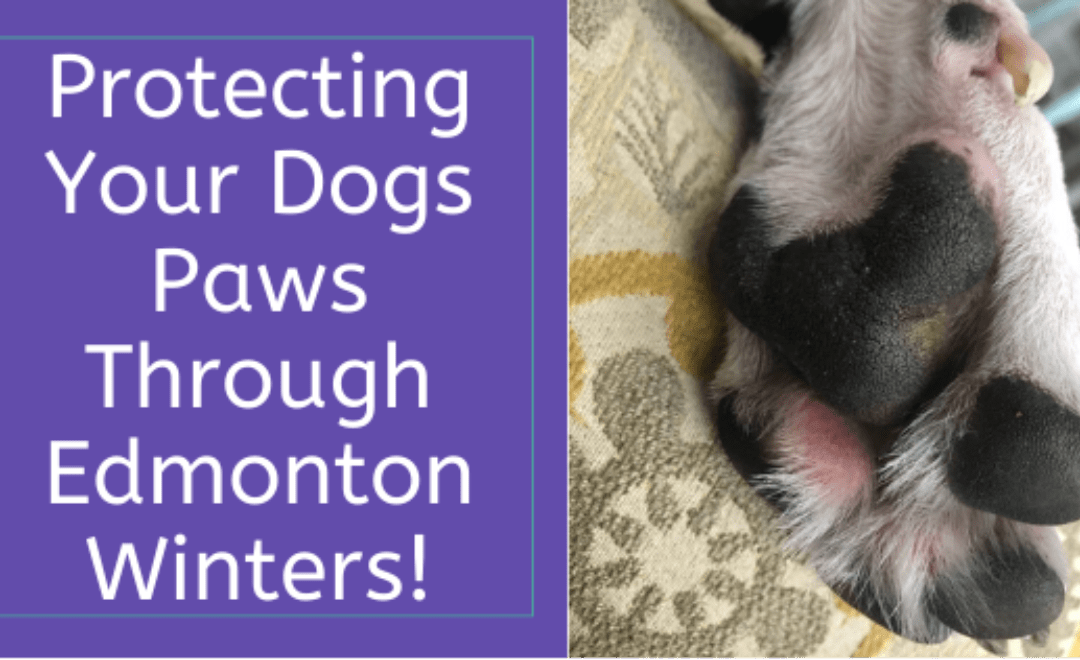Whether you like it or not, winter in Edmonton is here. One of the biggest challenges of winter that many dog owners face is all of the snow and ice on city walkways and streets and trying to protect their dog’s paws. Many dog owners have been faced with a situation where their dog will start lifting their paws or in some cases, sitting down during a dog walk due to their paws getting too cold or becoming irritated from salt.
Many people will use a lot of sand and salt to help melt the ice or make it easier for people to walk. The downside is that not everyone uses pet-friendly salt meaning that when your dog walks on it, it can burn their paw pads. So, what do you do to protect their paws besides pick them up and carry them or not walk them at all?
One solution is having your dog wear booties. There are thankfully many great options available and can fit any size of paws.
They can range in price anywhere from $30 up to $70.
You can purchase a pair at any pet store and it’s recommended that you bring your dog to the store to try them on as each pair is a bit different. Some are a bit easier to get on than others and some require multiple Velcro straps to be tightened. Some booties will have a bit of grip on the bottom so it depends on what kind of activity you are doing with your dog to keep in mind when selecting a pair of booties. Some booties are fleece lined to add extra warmth to their paws.
There are many great brands available out there for Edmonton dog owners to try. Some of the most popular brands out there are Muttlucks (these ones are fleece lined for extra warmth); Canine Equipment Ultimate Trail Boots are not only easy to take on and off and also have rubber soles which help with traction and are water-resistant; and Ultra Paws Durable Dog Boots are extremely easy for any dog owner to get on and off easily.
Some dogs will try and purposefully kick off their booties on a walk, so make sure that the Velcro straps are tight enough that they won’t fall off during a walk (because no one wants to retrace the steps of their cold winter walk in Edmonton to find a missing bootie).
It’s normal for your dog to be unsure and in some cases, downright mad about having to wear booties. It may take a few walks for them to get comfortable wearing them and many dogs will walk in a very exaggerated way for the first few steps. If your dog has never worn booties, try doing short distances to start so your dog can be used to wearing them and this will also prevent any issues such as chafing on your dog’s paws and dewclaws. Just like humans, it can take time to adjust to new shoes.
One issue that many dog owners who do use booties for their dogs are the issue of the booties rubbing their dog’s dewclaws. One way to prevent that from happening is trying to wrap their paws with a pet bandage wrap (available at most pet stores) to help protect against chafing. You could also put socks on their paws first and then put the booties on. You can either use baby socks or socks specifically for dogs.
What temperature would be recommended for a dog to wear booties? It depends. There are breeds of dogs who will require them any time it gets cold (below -5 degrees Celsius) such as Boston Terriers as they a breed that is not built for winter. Then there are dogs that are built for winters such as huskies or Bernese Mountain dogs that no matter how cold it gets outside, that don’t necessarily require booties. Every dog has a different tolerance level to cold and snow and if you are noticing your dog limping or consistently lifting their paws during walks in the winter, booties would be something to try with your dog.
There are going to be dogs that will refuse to wear booties no matter what. They will stand there and refuse to walk at all. So what do you do then?
If you find that is the case, try using a paw protector such as a paw wax to put on their paws prior to going outside. It helps create a bit of a base layer to help protect their paws from salt and sand. While it still won’t provide the same level of protection as booties (especially in really cold temperatures), it will help. Another great feature of using a product like a paw wax is that it’s great to use not only in the winter months but year-round as well. Just like it helps provide a protective layer against snow and ice, it can also help in the summer months protecting your dog’s paws from hot pavement and lawn chemicals. Paw waxes are made with all-natural ingredients such as coconut oil, so if your dog decides to start licking their paws, there will be no need for concern. If you notice your dog’s skin on their nose or elbows, you can use paw wax as a moisturizer for your dog.
Paw waxes are made with all-natural ingredients such as coconut oil, so if your dog decides to start licking their paws, there will be no need for concern. If you notice your dog’s skin on their nose or elbows, you can use paw wax as a moisturizer for your dog.
If you do use a paw wax or nothing at all on your dog’s paws, something that will also help reduce any irritation after their walk is wiping down all of their paws with hypoallergenic wipes. By wiping your dog’s paws down after a walk, it will help remove any salt, sand or ice that could get stuck and irritate your dog’s paw pads. This can be especially important for any dog with allergies.
Whether you choose to have your dog wear booties or use paw wax, there are many great options available for dog owners to keep their dog’s paws protected in harsh winter climates.




